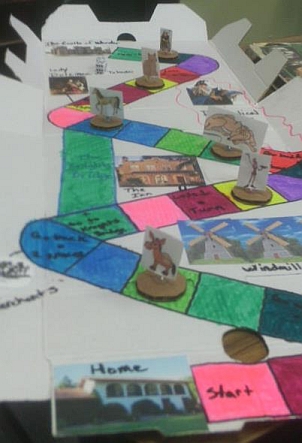C Is for Carrot
How many ways are their to motivate players? Well, if we’re to believe cliches, there are two: the carrot and the stick. Since today is C, I’m going to talk about the carrot. I know from years of teaching that a great way to get students invested in learning is to give them choices about how they want to show what they’ve learned. So, when we got done reading Don Quixote, my students didn’t have a single, mandatory assignment, but instead had their choice of one out of five or six different assignments. One of my students produced the delightful boardgame shown in the picture to the right as her project.

Borrowing an idea from Gnome Stew, you the GM can give your players choices in order to foster a greater sense of investment in your game. Give each player four index cards and about a week’s time. Ask them to write on each index card their ideas about what they’d like to encounter in the current campaign, dividing those likes into four categories: Enemy, Friend, Setting, and Reward. Let them be as vague or as specific as they’d like, as long as the idea fits on an index card. Let your players know that the ideas on the cards don’t need to be related to each other, although they could be. The cards also don’t need to be related to the player’s own character. Why suggest a reward for your character when you can suggest that a fellow player’s character receive the honor of an Amazonian queen asking for his hand in marriage?
Enemy: This could be something as simple as scrawling “ogres” on the card, or as involved as requesting the existence of a nefarious organization of wicked psions who masquerade as benevolent seekers of enlightenment. These cards are your players’ chance to get some of their favorite bad guys into game play, an option that could be especially attractive to folks who play rangers.
Friend: The PCs need more than just enemies. They should also have an assortment of friends, allies, and supporters, garnered during their adventures as well as part of their respective backgrounds. These friends can be valuable sources of aid and information, as well fodder for plot hooks.
Setting: A memorable setting can be a great boon for an encounter, an adventure, and even an entire campaign. Odds are good your players have always wanted to explore or survive some exotic place. I know I’ve always wanted to play through a high-action brawl atop a maze of unstable catwalks that collapse above a rumbling pool of magma.
Reward: Here’s your players’ chance to think outside the treasure box if they want. Forget yet another magic sword or a bag full of platinum. How about a grant of land accompanied by knighthood? Maybe free room and board for life at a famous tavern would be something worth having? A PC could somehow earn a reward that would otherwise be difficult to provide via the rules-as-written. I remember way back in 1E days when my dwarf fighter/thief acquired the ability to speak with wolves. Why? Because it was cool!
Best of all, encourage the players to not discuss their cards with each other. That way, as each requested element is brought into play, most of the players will be surprised by the turn of events. Imagine the limitless possibilities:
Terry: “The Amazon queen asked me what?”
Mark the GM: “For your hand in marriage before the assembled court of the Warrior Women. An expectant hush has fallen across the entire banquet hall. What do you do?”
Terry: “Wes, why are you giggling? Was this your idea?”


This is a great idea…I’ve got plans picked from my players who have invested a bit more in their PCs background but this is a great way to encourage a bit of thought from the more passive/casual players.
Cheers
Mark
Good idea, sometimes you’ve got to pull the players in a little more. It’s one of the things we’ve been hashing out with the D6 Epic system. Rewards for players who put more into the actual role-playing!